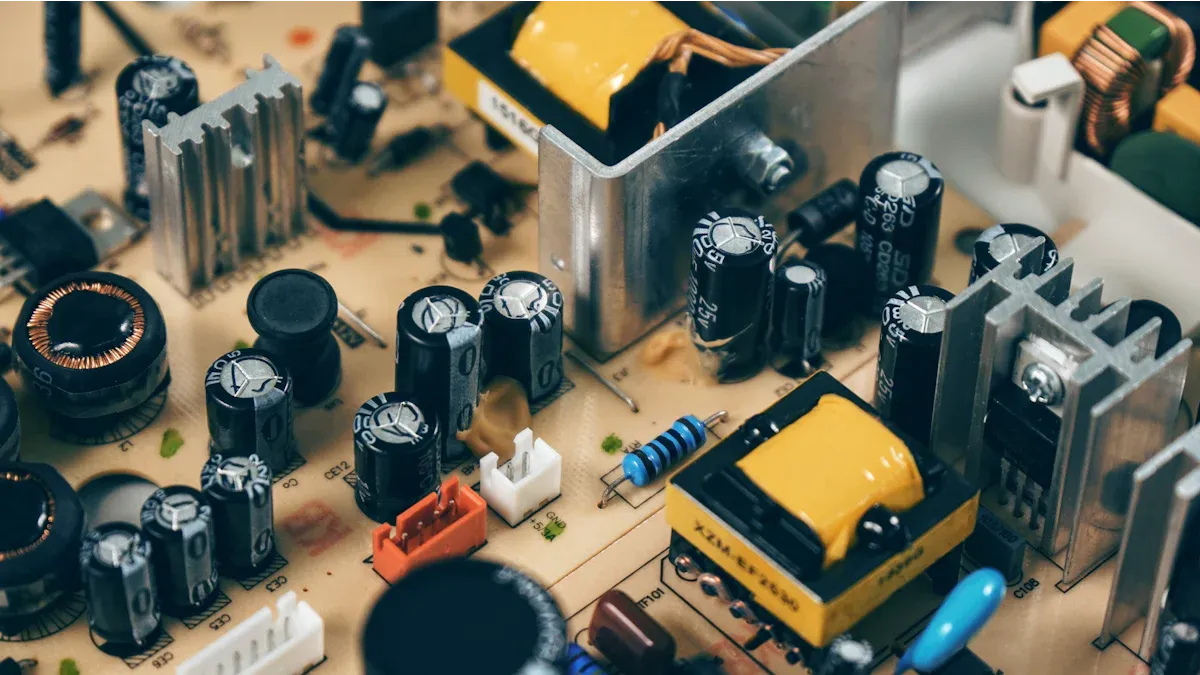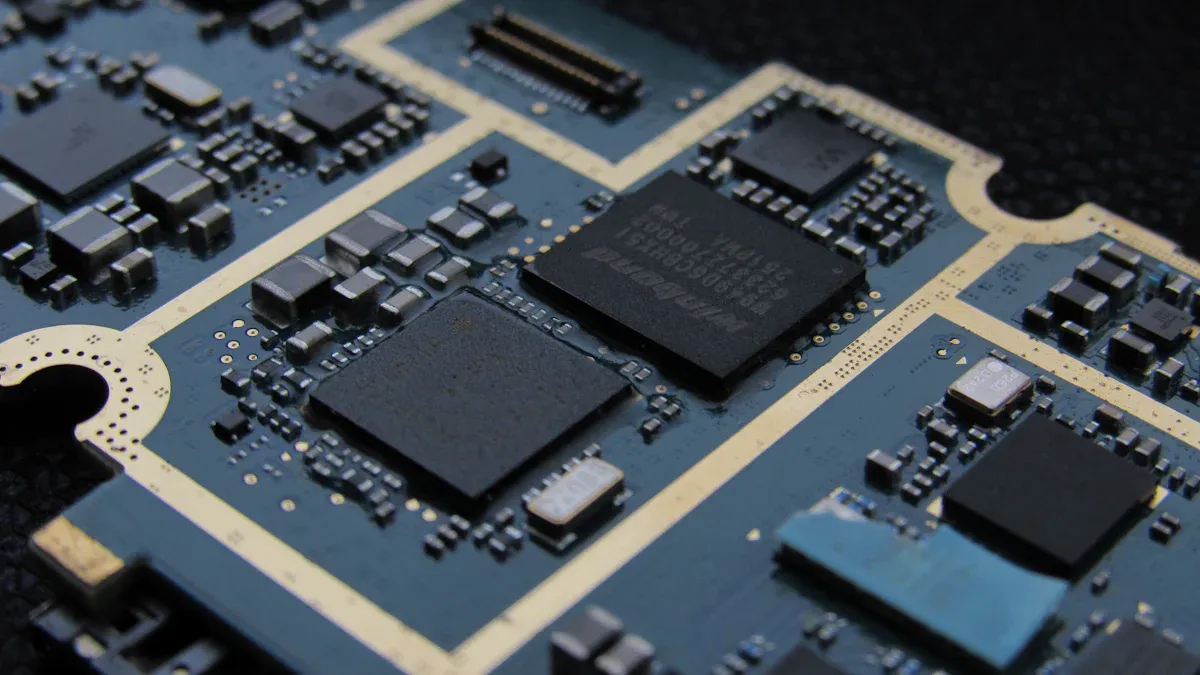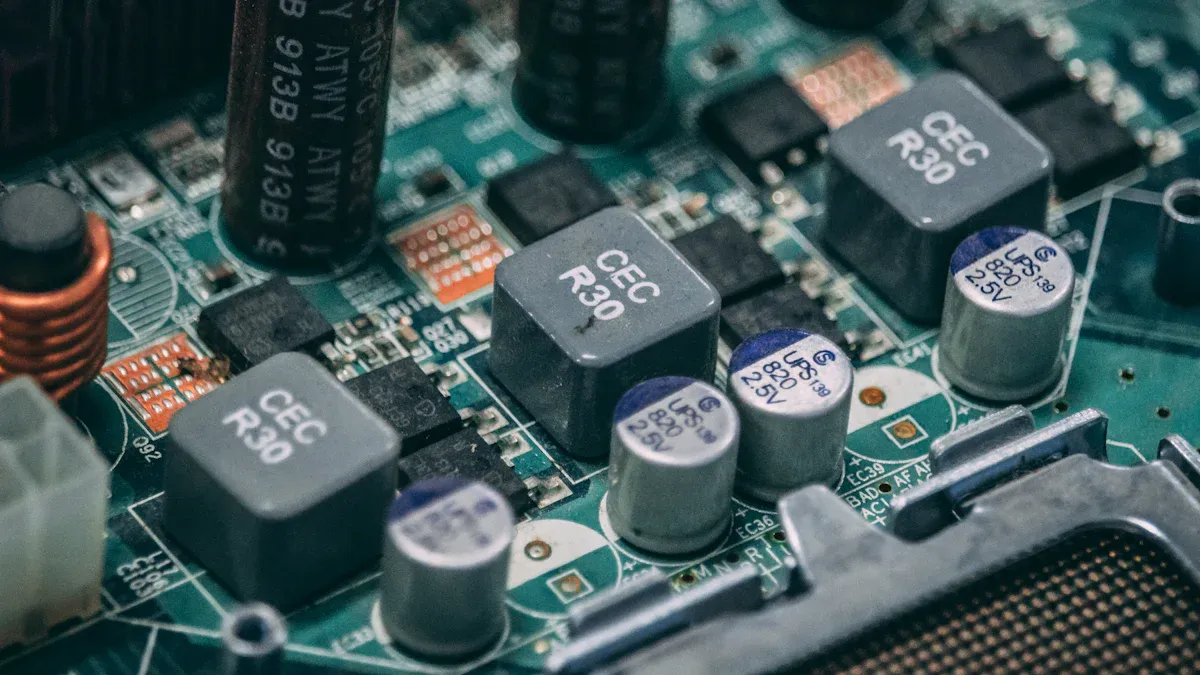What Is a Power Management Chip and How Does It Work

A power management chip controls and optimizes how electronic devices use electrical energy. This chip combines many functions, such as voltage regulation, battery management, and protection features, into a single component. It transforms and distributes power by using techniques like pulse-frequency modulation and pulse-width modulation. The chip monitors voltage, current, and temperature to keep devices safe. By managing these tasks, the power management chip helps devices run smoothly and efficiently.
Key Takeaways
Power management chips control and optimize how devices use electrical energy, helping them run efficiently and safely.
These chips regulate voltage, transform power, and manage battery charging to extend battery life and protect devices.
Integrated protection features prevent damage from overheating, overvoltage, and overcurrent, making devices more reliable.
Power management chips reduce the number of parts needed, saving space and improving device design.
They are essential in many devices like smartphones, cars, and industrial equipment, supporting longer use and better performance.
How Power Management Chips Work

Power Transformation
A Power Management chip transforms electrical energy to meet the needs of different parts inside a device. It controls how power moves from the battery or adapter to each circuit. The chip uses switches and converters to change voltage and current levels. For example, it can step down voltage for a processor or step up voltage for an LED backlight. The chip also reduces power use when the device is idle by turning off parts that are not needed. Software instructions can tell the chip when to change how much power it sends. This process helps save energy and keeps the device running smoothly. Most Power Management chips use a microcontroller to send commands to switches and converters, making sure each part gets the right amount of power. These chips often reach efficiency levels between 90% and 95%, which means they waste very little energy as heat.
Voltage Regulation
Voltage regulation is a key job for any Power Management chip. Devices need different voltage levels for their parts to work safely. The chip uses voltage regulators to keep these levels steady. There are two main types of voltage regulation: linear and switching.
Method | Description | Advantages | Disadvantages |
|---|---|---|---|
Linear Regulation (LDO) | Provides stable output voltage with a small voltage difference between input and output. | No switching noise, smaller circuit size, simple design. | Generates heat, lower efficiency. |
Switching Regulation | Uses high-frequency switching with inductors and capacitors to convert voltage efficiently. | High efficiency, supports higher currents, less heat. | More complex, possible switching noise. |
Buck Converter | Steps voltage down. | High efficiency, uses PWM or PFM. | Needs extra components. |
Boost Converter | Steps voltage up. | Useful for increasing voltage. | More complex, needs extra parts. |
Buck-Boost Converter | Can step voltage up or down. | Flexible for many needs. | Complex control. |
The chip often combines several types of regulators to match the needs of each device part. Integrated voltage regulators (IVRs) sit close to the processor, which cuts down power loss and saves space on the circuit board. IVRs can change voltage very quickly, helping the device save power during fast changes in activity. This tight control means less wasted energy and better battery life.
Tip: Fast voltage changes and close placement of regulators help devices like smartphones and laptops run longer and stay cooler.
Energy Distribution
A Power Management chip distributes energy to all the subsystems in a device, such as the processor, memory, and sensors. It uses smart controllers and interfaces to send the right amount of power where it is needed. For example, the chip can use a high-speed interface to talk with different parts of the device, making sure each one gets enough power without wasting energy. The chip can also adjust voltage and current based on what the device is doing. If the device is in sleep mode, the chip lowers power to save battery. When the device wakes up, the chip quickly increases power to the active parts.
Power Management chips often include:
Multiple voltage regulators for different subsystems.
Controllers that monitor and adjust power flow.
Features for battery charging and protection.
Modes for sleep and low power to extend battery life.
The chip can detect when the device is not being used and switch to a low-power state. It can also manage battery charging by turning off charging when the adapter voltage drops or when the battery is full. These features help devices last longer and stay safe.
Power Management Chip Functions
Battery Management
A Power Management chip plays a key role in battery management. It controls how the battery charges and discharges, making sure the battery stays healthy and lasts longer. The chip uses smart algorithms to measure the battery’s state of charge and identify the battery chemistry. This helps the device know exactly how much energy remains.
Ultra-efficient boost regulators help extend battery life and allow for smaller batteries.
Advanced power modes, such as ship and hibernate, support devices that do not need to run all the time.
High-accuracy voltage and temperature monitoring keeps the battery safe.
The chip supports many battery types and configurations, including single-cell and multicell packs.
It works with software development kits for easy setup and control.
The chip prevents overcharging by stopping the charge at safe voltage levels, usually around 4.2V. It also stops the battery from discharging too much, which can damage the battery. By keeping the battery within safe voltage ranges, the chip helps the battery last through more charge cycles. Some devices use charging strategies that stop charging at 80% to slow down battery wear. This careful control protects the battery and extends its usable life.
Note: Accurate battery management is important for devices like medical tools, wireless sensors, and electric vehicles. It keeps them running safely and for longer periods.
Power Conversion
Power conversion is another main function of a Power Management chip. The chip changes electrical energy from one form to another so each part of the device gets the right voltage and current. It uses several techniques to do this:
Pulse-Width Modulation (PWM) controls how long a switch stays on to keep voltage steady.
Pulse-Frequency Modulation (PFM) adjusts how often the switch turns on and off for better efficiency.
Low-Dropout Regulators (LDOs) provide simple voltage control for sensitive parts.
DC-DC converters change one voltage level to another, making power supply design easier.
Switching amplifiers and power MOSFETs help control and move power efficiently.
Switching regulators, such as buck converters, can reach up to 95% efficiency. They waste less energy as heat and help devices run cooler. Linear regulators are simpler but lose more energy as heat, which can shorten battery life. Advanced buck converters also have low-power modes for better efficiency when the device is not working hard.
Power Conversion Method | Efficiency | Heat Generation | Complexity | Best Use Case |
|---|---|---|---|---|
Switching Regulator | Up to 95% | Low | High | High-power, efficient systems |
Linear Regulator (LDO) | Low | High | Low | Simple, low-noise circuits |
Protection Features
A Power Management chip includes many protection features to keep devices safe. It guards against electrical problems like overvoltage, undervoltage, and overcurrent. The chip uses built-in field effect transistors (FETs), current sensing, and limiting circuits to watch for dangerous conditions. If the chip detects too much current or voltage, it can shut down or limit power to prevent damage.
The chip also protects against thermal faults. It monitors temperature and can turn off parts of the device if they get too hot. Some chips include power sequencing and sleep modes to lower heat when the device is not busy. In automotive and battery systems, the chip works with cooling systems to keep everything at a safe temperature.
Tip: Integrated protection features help devices last longer and work more reliably, even in tough conditions.
Power Management chips combine all these functions into one small package. This integration reduces the number of separate parts needed and saves space on the circuit board. For example, a single chip can replace many individual regulators and protection circuits, cutting the component count by up to 75% and shrinking the board space by 80%.
Feature | Discrete Solution | PMIC Solution |
|---|---|---|
Number of Components | 100% (baseline) | 25% (75% fewer) |
Board Space (Footprint) | 100% (baseline) | 20% (80% smaller) |
This high level of integration makes devices more efficient, reliable, and compact.
Types of Power Management Chips

Power management chips come in several types, each designed for specific roles in electronic devices. The main categories include Power Management ICs (PMICs), voltage regulators, and battery management ICs. The table below highlights their key features and typical uses:
Type of Power Management Chip | Distinguishing Features | Typical Applications |
|---|---|---|
PMICs | Integrate multiple functions like voltage regulation, current sensing, and protection on a single chip. Reduce component count and size. | Versatile power management in smartphones, wearables, IoT, and complex electronics. |
Maintain stable output voltage. Include linear (low noise) and switching (high efficiency) types. | Used where voltage stability is critical, such as processors and memory. | |
Battery Management ICs | Manage battery charging, discharging, and safety. Provide monitoring and protection. | Essential for battery-powered devices like smartphones and electric vehicles. |
PMICs
PMICs, or Power Management Integrated Circuits, combine many power functions into one chip. They handle voltage regulation, battery management, power sequencing, and protection. Manufacturers use advanced processes to fit analog, digital, and power blocks together. PMICs often include communication interfaces like I²C or SPI for real-time control and monitoring. These chips support techniques such as pulse-frequency modulation and pulse-width modulation for efficient power conversion. PMICs can reach up to 95% efficiency and enable dynamic voltage and frequency scaling. They also provide built-in protection against overvoltage, undervoltage, and overcurrent. PMICs help designers save space and simplify circuit boards.
Note: PMICs often manage power sequencing, ensuring safe startup and shutdown of device components.
Voltage Regulators
Voltage regulators keep the output voltage steady, even when the load or input changes. Two main types exist: linear regulators and switching regulators. Linear regulators use a transistor and an operational amplifier to control voltage with low noise. Switching regulators use high-speed switches, inductors, and capacitors for efficient voltage conversion. These regulators provide good load and line regulation, which means they keep voltage stable during rapid changes. Protection circuits prevent damage from overcurrent or overheating. Voltage regulators are important in devices that need constant voltage, such as processors and memory chips.
Key features of voltage regulators:
Fast response to load changes
Low noise (linear type)
High efficiency (switching type)
Built-in protection circuits
Battery Management ICs
Battery management ICs focus on charging, discharging, and protecting batteries. These chips measure voltage, current, and temperature with high accuracy. They use advanced algorithms to estimate battery state-of-charge and state-of-health. Many battery management ICs support multiple battery cells and offer cell balancing to extend battery life. Modern designs include communication interfaces like UART, SPI, or CAN for data sharing. Some chips use AI or machine learning to predict battery performance and improve safety. Battery management ICs also feature ultra-low power modes to preserve energy when not in use.
Advanced features in battery management ICs:
Accurate monitoring and data logging
Fast hardware shutdown for safety
Support for predictive maintenance
Tip: Battery management ICs play a vital role in portable devices, electric vehicles, and energy storage systems.
Applications
Consumer Electronics
Power management chips play a vital role in smartphones, tablets, and wearables. These chips help devices run longer and stay cool by using advanced techniques. For example, dynamic voltage and frequency scaling (DVFS) adjusts power based on what the device is doing. Power gating turns off parts of the chip that are not in use. Adaptive voltage scaling (AVS) fine-tunes voltage in real time. These methods save energy and keep performance high.
Technique | Description | Impact on Battery Life and Performance |
|---|---|---|
Dynamic Voltage and Frequency Scaling (DVFS) | Adjusts voltage and frequency based on workload. | Reduces power use during light tasks, keeps speed for heavy tasks. |
Power Gating | Shuts off power to unused chip sections. | Cuts wasted energy, extends battery life. |
Adaptive Voltage Scaling (AVS) | Changes voltage supply in real time. | Saves energy without lowering performance. |
Low-Power Components | Uses parts that need less power. | Helps devices last longer on a charge. |
Software Optimization | Smart scheduling by the operating system. | Balances power use and keeps battery healthy. |
Many modern chips, like MediaTek Dimensity and Samsung Exynos, use these features. They also include special AI units and support for fast 5G networks, which helps balance speed and battery life. Power management chips also protect batteries from overcharging and overheating, making devices safer and more reliable.
Automotive
Modern vehicles rely on power management chips for safety, efficiency, and comfort. These chips ensure that every electronic system, from engine control to infotainment, gets steady power. They help cars save fuel by managing alternator use and supporting energy recovery during braking. Power management chips also extend battery life and support advanced features like driver assistance.
Key Role | Explanation |
|---|---|
Keeps all vehicle electronics running smoothly and safely. | |
Enhancing Fuel Efficiency | Optimizes alternator and supports energy recovery to save fuel. |
Extending Battery Life | Manages charging and balances energy for longer battery use. |
Supporting Advanced Electronics | Powers systems like ADAS and infotainment without overload. |
Dynamic Load Management | Prioritizes critical systems and sheds non-essential loads when needed. |
Power management chips also handle voltage swings from start-stop engines and regenerative braking. They include protection circuits and support safety standards, such as ISO 26262, to keep vehicles safe and reliable.
Industrial and IoT
Factories, smart buildings, and IoT devices depend on advanced power management chips. These chips help devices run longer, even in tough environments. They manage energy from different sources, like batteries and solar panels, and use features such as dynamic voltage scaling and cold-start functions for battery-less operation.
Key benefits for industrial and IoT applications:
Multisource energy harvesting for longer device life
Dynamic voltage and frequency scaling to save power
Cold-start for battery-free operation
Maximum power point tracking for efficient energy use
Low standby power for always-on sensors
Power management chips also support secure communication and edge computing. They protect against heat and electrical faults, which keeps systems running smoothly. These features make them essential in smart meters, industrial sensors, medical devices, and automated farms.
Power Management chips enable efficient, reliable, and compact electronic devices by integrating multiple power functions into a single solution. Their advanced features support energy savings, device reliability, and longer battery life. The table below highlights why these chips matter in modern technology:
Aspect | Why It Matters |
|---|---|
Reduces power loss and heat | |
Device Reliability | Ensures stable operation under changing conditions |
Compact Design | Supports smaller, lighter devices |
People rely on these chips every day, from smartphones to electric vehicles.
FAQ
What devices use power management chips?
Power management chips appear in smartphones, laptops, tablets, smartwatches, electric vehicles, and industrial machines. These chips help each device use energy efficiently and safely.
How does a power management chip save battery life?
The chip controls how much power each part of a device receives. It turns off unused sections and lowers voltage when possible. This careful control helps batteries last longer.
Can a power management chip prevent device overheating?
Yes. The chip monitors temperature and can shut down or reduce power to hot parts. This action protects the device from damage and keeps it running safely.
Are power management chips important for safety?
Absolutely. These chips stop overcharging, prevent short circuits, and guard against high temperatures. They help keep devices safe for users.
See Also
Understanding The Functionality Of SON8 Power Management Chips
Exploring How Power Supply Chips Operate And Function
The Role And Importance Of Power Management ICs In Tablets
Why ON Semiconductor Power Management Is Crucial Today
A Comprehensive Guide To Understanding Computer Chips Functionality
